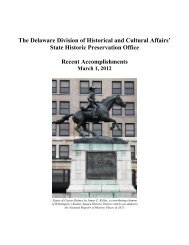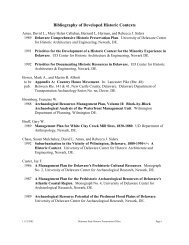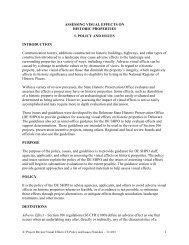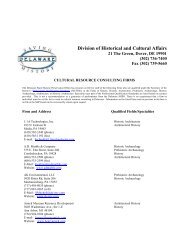Report of the Archaeological Investigations of the New Castle Court ...
Report of the Archaeological Investigations of the New Castle Court ...
Report of the Archaeological Investigations of the New Castle Court ...
Create successful ePaper yourself
Turn your PDF publications into a flip-book with our unique Google optimized e-Paper software.
NEW CASTLE COURT HOUSE PLAZA<br />
NEW CASTLE, DELAWARE<br />
5.0 INTERPRETATION AND CONCLUSIONS<br />
The presence <strong>of</strong> palisade lines beneath <strong>the</strong> plaza raises a number <strong>of</strong> questions concerning <strong>the</strong> pre-<br />
1732 uses <strong>of</strong> <strong>the</strong> <strong>Court</strong> House lot and <strong>the</strong> function <strong>of</strong> <strong>the</strong> massive stone foundation discovered<br />
beneath <strong>the</strong> <strong>Court</strong> House during <strong>the</strong> 1950s restoration. It has long been held that <strong>the</strong> foundation<br />
under <strong>the</strong> <strong>Court</strong> House, measuring 30 feet square, was <strong>the</strong> original <strong>Court</strong> House building with<br />
various construction dates reported as 1689 and 1704. Extensive historical research and<br />
architectural investigation was completed before and during <strong>the</strong> restoration work, and <strong>the</strong><br />
presence <strong>of</strong> <strong>the</strong> stone foundation, measuring in some places nearly 2.5 feet thick, seemingly<br />
confirmed <strong>the</strong> historical record. However, a foundation <strong>of</strong> such dimensions is quite large,<br />
particularly when it would have supported a building <strong>of</strong> only one-and-a-half stories. It is <strong>the</strong>refore<br />
likely that <strong>the</strong> stone foundation beneath <strong>the</strong> <strong>Court</strong> House represents a building initially<br />
constructed with a purpose o<strong>the</strong>r than that which it eventually served.<br />
There are multiple references in <strong>the</strong> documentary record to blockhouses in and around <strong>the</strong> village<br />
<strong>of</strong> <strong>New</strong> <strong>Castle</strong> during <strong>the</strong> last quarter <strong>of</strong> <strong>the</strong> seventeenth century (Appendix IV). In <strong>the</strong> spring <strong>of</strong><br />
1670 William Tom and Peter Alrichs wrote to <strong>the</strong> Governor that <strong>the</strong>y planned to build a<br />
blockhouse in <strong>the</strong> middle <strong>of</strong> <strong>the</strong> town. The fortification <strong>of</strong> Fort Casimir, <strong>the</strong>y noted, was in<br />
disrepair and poorly sited to defend <strong>New</strong> <strong>Castle</strong>. The intention <strong>of</strong> <strong>the</strong> inhabitants was to reuse<br />
building materials from <strong>the</strong> fort in <strong>the</strong> new construction. They also commented that if <strong>the</strong> new<br />
blockhouse was not necessary for defense it could be used as a court house (Gehring 1977:11). In<br />
October Captain Carr <strong>of</strong> <strong>New</strong> <strong>Castle</strong> endorsed <strong>the</strong> proposal to <strong>the</strong> Governor and added that<br />
fortifications (more than one) may be necessary (Scharf 1888). Later in <strong>the</strong> year <strong>the</strong> Governor’s<br />
Council agreed to <strong>the</strong> new construction. The locations <strong>of</strong> <strong>the</strong> new blockhouses were left to <strong>the</strong><br />
discretion <strong>of</strong> <strong>the</strong> people <strong>of</strong> <strong>the</strong> town, and it was also stipulated that if <strong>the</strong> buildings were not used<br />
for defense <strong>the</strong>y could serve in public capacities such as council house and prison (Gehring<br />
1977:15).<br />
While <strong>the</strong> blockhouse was apparently begun in 1671 it was still incomplete in August <strong>of</strong> 1672.<br />
According to Captain Carr <strong>the</strong> unfinished blockhouse was in such poor condition that it was<br />
rotting (Gehring 1977:39). The Governor in <strong>New</strong> York reissued orders to speed its completion,<br />
threatening fines on <strong>the</strong> inhabitants <strong>of</strong> <strong>New</strong> <strong>Castle</strong> if it was not completed by November. At <strong>the</strong><br />
same time Governor ordered that “great guns” or cannons be sent to <strong>the</strong> settlements on <strong>the</strong><br />
Delaware River and mounted in <strong>the</strong> blockhouses (Gehring 1977:41).<br />
The documentary record is confusing on <strong>the</strong> issue <strong>of</strong> whe<strong>the</strong>r this first blockhouse was<br />
completed. The seizure <strong>of</strong> Delaware River settlements by <strong>the</strong> Dutch in 1673-74 may have<br />
curtailed fur<strong>the</strong>r work on <strong>the</strong> blockhouse at <strong>New</strong> <strong>Castle</strong>. By <strong>the</strong> summer <strong>of</strong> 1675 <strong>the</strong> magistrates<br />
at <strong>New</strong> <strong>Castle</strong> requested <strong>of</strong> Governor Andros that <strong>the</strong>y be allowed to “remove” <strong>the</strong> blockhouse at<br />
<strong>New</strong> <strong>Castle</strong>. The magistrates felt that a court house and prison were needed in <strong>the</strong> town. A reason<br />
<strong>of</strong>fered for <strong>the</strong> removal <strong>of</strong> <strong>the</strong> blockhouse was that its siting was detrimental to <strong>the</strong> town (Gehring<br />
1977:97-98).<br />
In September <strong>of</strong> 1675 <strong>the</strong> Council at <strong>New</strong> York ordered that <strong>the</strong> blockhouse at <strong>New</strong> <strong>Castle</strong> be<br />
taken down and a new blockhouse be constructed “at ye back side <strong>of</strong> ye Towne, about ye middle<br />
<strong>of</strong> it, at or near ye olde Block House” (Scharf 1888). This statement indicates that <strong>the</strong>re was an<br />
earlier “olde” blockhouse at <strong>New</strong> <strong>Castle</strong> at this time, and it may be that this blockhouse was <strong>the</strong><br />
one requested by <strong>the</strong> magistrates in 1670, described as incomplete in 1671, and finished circa<br />
1672. This blockhouse stood from circa 1672 to 1675. A second blockhouse was ordered in 1675,<br />
and this building was also to house a courthouse and prison (Scharf 1888). Coupled toge<strong>the</strong>r, <strong>the</strong><br />
historical and archeological information suggests that two fortifications may have stood on <strong>the</strong><br />
green in <strong>the</strong> last quarter <strong>of</strong> <strong>the</strong> seventeenth century.<br />
85









